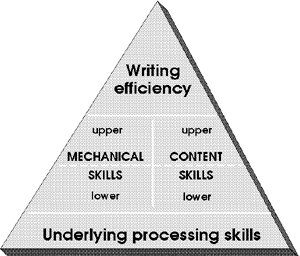![]()
Regina G. Richards, M.A.
Educational
Therapist
May 1999
 It is common for students in today's educational
system to dislike and/or avoid the writing process. Many students feel writing
takes too long. For some, writing is a very laborious task because there
are so many subcomponents which need to be pulled together. For others, the
reason lies in some processing difficulties, such as dyslexia or dysgraphia.
Some educators wonder if students no longer enjoy the slower, more refined
process of written communication because they spend so much time watching the
faster-paced visual modality of television.
It is common for students in today's educational
system to dislike and/or avoid the writing process. Many students feel writing
takes too long. For some, writing is a very laborious task because there
are so many subcomponents which need to be pulled together. For others, the
reason lies in some processing difficulties, such as dyslexia or dysgraphia.
Some educators wonder if students no longer enjoy the slower, more refined
process of written communication because they spend so much time watching the
faster-paced visual modality of television.
Students with learning problems, even those who read well, frequently submit written work which is brief and/or difficult to read. Such students can be victims of misunderstandings, a problem which becomes much more pronounced at the secondary level. "Accusations of laziness, poor motivation, and a reprehensible attitude are often directed toward deficit writers. The results can be a serious loss of incentive, a generalized academic disenchantment and demoralization" (Levine 1998, 363).
As parents and teachers, we can help students deal with their lack of enjoyment of the writing process and also with poor skill development. The techniques are twofold. Students need to:
When students have a combination of this understanding and the skills, they are then free to apply techniques and abilities in a wide range of situations. This is especially true and necessary for dyslexic and/or dysgraphic students who are compensating for processing inefficiencies in the language domain.

Skill Development
This graphic represents the necessary steps in developing writing skills. These steps are in a hierarchy: if a student has too many gaps in one (or more) of the lower levels, then the top levels may be shaky and unstable.
The underlying processing skills involve development in a variety of memory,
motor, and language areas. Examples include:![]() Physical components of writing
Physical components of writing![]() Speed of motor performance
Speed of motor performance![]() Active working memory
Active working memory![]() Language formulation and ideation
Language formulation and ideation
The mechanical skills involve lower level tasks such as automatic letter
form, use of space, basic spelling, capitalization, and punctuation. More mature
mechanics involve speed, clarity of expression, and appropriate grammar.
The
content skills relate to organizing and expressing ideas. The upper level skills
include:
Overall guidelines to help students avoid the avoidance of
writing
There are many reasons a student may avoid writing, but most relate to the concept that writing is not fun or enjoyable. When writing is not meaningful, it is difficult to pull together the variety of skills needed to develop enthusiasm about writing. Students learn to write by writing, which then gives them the confidence to continue to write and continue to develop their skills. Using a variety of modalities can help create enthusiasm for writing and help students view writing as a more meaningful activity.
It is also important to analyze the lower level skills to ensure that the student has appropriately developed automaticity in these skills. When students are frustrated with individual components related to the task of writing and/or when they struggle to get started or to keep track of their thoughts, then the writing process is not fun, and their lack of enthusiasm becomes evident. Writing remains at the level of drudgery no matter how exciting the topic and students may feel threatened by the process of writing.
The goal for these students is to reduce the frustration, struggles, and feeling of threat. Increasing automaticity of skills is required to increase overall writing automaticity for a student. When automaticity, as developed by metacognitive awareness of the writing process and use of specific strategies, is combined with skill development and bypass strategies, the student should be able to deal with the vast majority of written expression tasks. The next step is to integrate purpose and meaning to generate fun and lead to enthusiasm for writing.
References
Acosta, Simone and Richards, Regina G. "Cursive Writing:
A Multisensory Approach," in 1999 So. California Consortium Resource
Directory, International Dyslexia Association,
www.retctrpress.com.
Levine, Melvin D. Developmental Variation and
Learning Disorders, 2nd ed., www.epsbooks.com.
Levine, Melvin D.
Educational Care: A System for Understanding and Helping Children with
Learning Problems at Home and in School,
www.epsbooks.com.
Richards, Regina G. The Source for Dyslexia and
Dysgraphia, East Moline, IL: LinguiSystems, 800/PRO-IDEA.
Richards, Regina G. When Writing's A Problem, Riverside, RET Center Press, www.retctrpress.com.
Richards, Regina G. The Writing Dilemma: Understanding Dysgraphia, Riverside, RET Center Press, www.retctrpress.com.
Many appropriate articles can be found in the Spring 1998 issue of Perspectives, the magazine of the International Dyslexia Association (www.interdys.org). This issue focuses on the theme of technology and learning disabilities and includes the following articles which relate to dysgraphia:
Jerome Elkind (The Lexia Institute, Los Altos, CA) "Computer Reading Machines
for Poor Readers."
Charles A. MacArthur, Ph.D. (University of Delaware)
"Assistive Technology for Writing."
Marshall H. Raskind, Ph.D. (The Frostig
Center, Pasadena, CA) "Assistive Technology for Individuals with Learning
Disabilities: How Far Have We Come?"
Thomas G. West (Visualization Research,
Washington, D.C.) "Words to Images: Technological Change Redefines Educational
Goals."
Marshall H. Raskind, Ph.D. and Toby Shaw, M.A. (The Frostig Center,
Pasadena, CA) "Assistive Technology for Persons with Learning Disabilities:
Product Resource List."
About the
Author:
 |
Regina G. Richards, M.A., began her work in bilingual education, working on curriculum development and test design. She has authored books on language development, reading strategies, and classroom visual development, and throughout her years of working in education, she has presented a wide range of workshops at conferences. Since 1970, she has been an instructor at the University of California Extension Programs at both the Riverside and San Diego campuses. She is director of the Richards Educational Therapy Center and Big Springs School, both of which serve many dyslexia and dysgraphic students. She was president of her local branch of the International Dyslexia Association for seven years and continus to be actively involved. |
Publications by Regina G. Richards
Receive monthly updates about new information & activities on this website!
© Copyright 1996-1999 WETA.